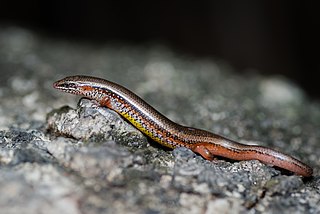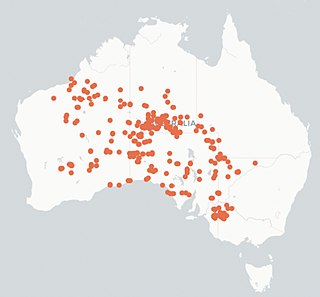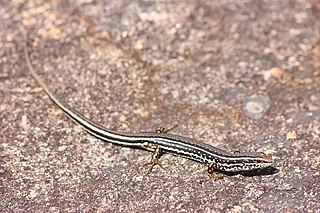
Subdoluseps bowringii, also known commonly as Bowring's supple skink, Bowring's writhing skink, and the Christmas Island grass-skink, is a species of lizard in the subfamily Lygosominae of the family Scincidae. The species is native to Southeast Asia.

Riopa guentheri, commonly known as Günther's supple skink and Günther's writhing skink, is a species of lizard in the family Scincidae. The species is endemic to India.
Vosmer's writhing skink is a species of skink, a lizard in the family Scincidae. The species is endemic to India.

Sphenomorphus dussumieri, commonly known as Dussumier's forest skink and Dussumier's litter skink, is a species of skink, a lizard in the family Scincidae. The species is endemic to southern India.

Pseudemoia entrecasteauxii, also known commonly as Entrecasteaux's skink, the southern grass skink, the tussock cool-skink, and the tussock skink, is a species of lizard in the family Scincidae. The species is endemic to Australia.

Ctenotus strauchii, also known commonly as the eastern barred wedge-snout ctenotus or Strauch's ctenotus, is a small species of lizard in the family Scincidae. The species is endemic to Australia and is found throughout semi-arid and arid regions in most of Australia's mainland states except Western Australia, although one record does exist for Western Australia in 1975.

Otosaurus cumingii, commonly called Cuming's sphenomorphus or the Luzon giant forest skink, is a species of skink, a lizard in the family Scincidae. The species is endemic to the Philippines.

Lipinia pulchella, known commonly as the yellow-striped slender tree skink or beautiful lipinia, is a species of skink, a lizard in the family Scincidae. The species is endemic to the Philippines.
Emoia baudini, also known commonly as Baudin's emo skink, Baudin's skink, and the Great Bight cool-skink, is a species of lizard in the family Scincidae. The species is native to New Guinea, Maluku, and Sulawesi.
Carlia beccarii is a species of skink, a lizard in the subfamily Eugongylinae of the family Scincidae. The species is endemic to Indonesia.

Saproscincus challengeri, also known commonly as the Border Ranges shadeskink, Challenger's skink, the challenging shade skink, and the orange-tailed shadeskink, is a species of lizard in the family Scincidae. The species is native to New South Wales and Queensland in Australia.

Mochlus sundevallii, also known commonly as Peters' eyelid skink, Peters' writhing skink, and Sundevall's writhing skink, is a species of lizard in the family Scincidae. The species is endemic to Sub-Saharan Africa.
Ctenotus ariadnae, also known commonly as Ariadna's ctenotus, is a species of skink, a lizard in the family Scincidae. The species is endemic to Australia.

Ctenotus brooksi, also known commonly as Brooks' wedge-snouted ctenotus, the wedgesnout ctenotus, and the sandhill ctenotus, is a species of skink, a lizard in the family Scincidae. The species is endemic to Australia and found in semi-arid regions.
Ctenotus colletti, also known commonly as the buff-tailed finesnout ctenotus, Collett's ctenotus, and Collett's skink, is a species of lizard in the family Scincidae. The species is endemic to Australia.
Ctenotus greeri, also known commonly as Greer's ctenotus and the spotted-necked ctenotus, is a species of skink, a lizard in the family Scincidae. The species is endemic to Australia.
Ctenotus hanloni, also known commonly as Hanlon's ctenotus and the nimble ctenotus, is a species of skink, a lizard in the family Scincidae. The species is endemic to Australia.

Ctenotus labillardieri, also known commonly as the common south-west ctenotus, Labillardier's ctenotus, and the red-legged ctenotus, is a species of skink, a lizard in the family Scincidae. The species is endemic to the Australian state of Western Australia.

Kaestlea beddomii, also known as Beddome's ground skink, is a species of lizard in the family Scincidae. The species is endemic to the Western Ghats of India.

Jagor's sphenomorphus is a species of skink, a lizard in the family Scincidae. The species is endemic to the Philippines. There are two recognized subspecies.














